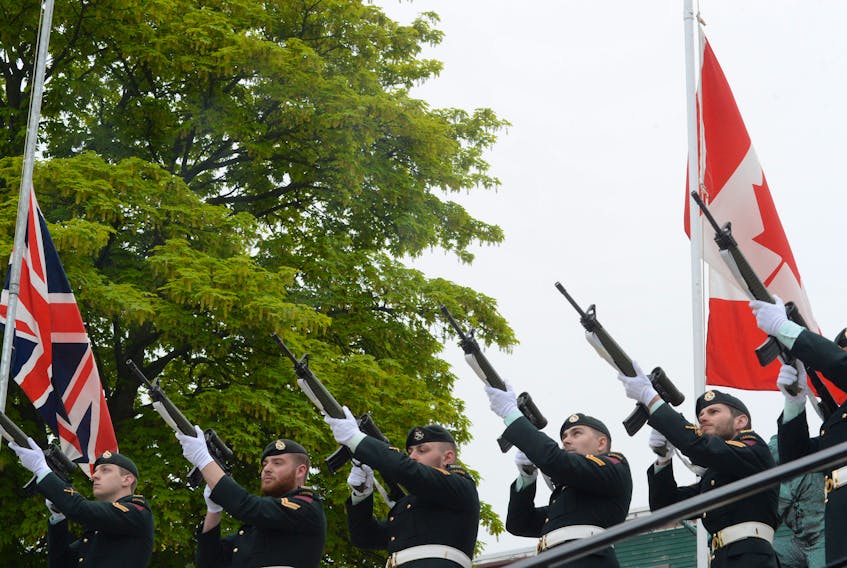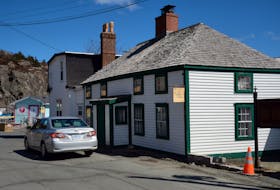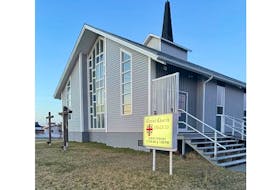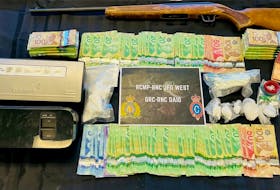ST. JOHN'S, N.L. — All you could hear were the seagulls and the sound of the wind coming off of St. John’s harbour.
It grew quiet when members of the 1st Battalion of the Newfoundland Regiment fired three shots into the late morning fog to commemorate the 103rd Memorial Day, held at the War Memorial in downtown St. John’s. And then there was more silence.
A small number of veterans were on hand for the ceremony to honour their colleagues from the Second World War and the Korean Conflict, in addition to the names and memories of those who perished during the First World War and in particular the members of the Newfoundland Regiment who fought and died at Beaumont Hamel during the opening day of the Battle of the Somme on July 1, 1916.
“There were only half a dozen veterans who participated this year, which has been constant for the past four or five years,” said Paul Hillier, executive director of the Royal Canadian Legion Newfoundland and Labrador Command.
“The Korean War veterans, those from the Second World War, all want to preserve the memory of those they served with, in addition to remembering all those who died at Beaumont Hamel.’’

Once Britain declared war on Germany in August 1914, Newfoundland was automatically at war.
The 1st Newfoundland Regiment, the first 500, was assembled and trained, with these first recruits sent overseas in October 1914 to become a unit of the British Army. They became known as the Blue Puttees because of the colour of the uniform leggings they wore.
The 1st Newfoundland Regiment suffered great losses at Beaumont-Hamel, as only 68 out of 801 1st Newfoundland Regiment members who went over the top that day answered roll call the following morning.
Charlie Starkes was born in Greenspond, but grew up in St. John’s before enlisting and serving in the Royal Navy from 1940-44 as a torpedo man.
He was present on D-Day (June 6) when the troops landed on the beaches of Normandy and was one of the survivors of his group.
“There are only five of us left. We all went to Halifax last month for the ceremony,’’ Starkes said.
“If I get some of the facts wrong, people will forgive me. I am 97. But that event and ones like today are important to me, to honour the men I served with. The ones that didn’t make it home and those who did.’’
Starkes is a member of the Singing Legionnaires and for the past 53 years hasn’t missed a day.
Leading Aircraftsman Earl Parrott, 94, was a member of the Royal Air Force (RAF) and had a unique story of how he arrived there.
Born in Pennsylvania to parents who were born in Newfoundland, he started his life in the United States.

His brother, who also served in the RAF, became ill, which forced the family to return to Newfoundland.
“I was raised here, so when it came time to decide what I was going to do, I signed up in 1943,’’ Parrott said, noting the family history of service. His father served in the navy in the First World War in what would have been the British Navy at that time.
“I had a cousin who was in the navy, serving on the Avenger, who didn’t make it home. He always told me that if they came under attack, from where he was located on the ship, that would be the case.’’
Also on hand was Lt.-Col. Kurt Brown, the Australian Defence Adviser to Canada, who made the trip to Newfoundland and Labrador to help commemorate the sacrifices made at Beaumont-Hamel in 1916, but also in Gallipoli, where the Newfoundland Regiment fought side by side with the Australians.
He said his country hosts Anzac Day on April 25 each year, a day that is similar to D-Day and Memorial Day in Canada.
“A representative from the Royal Newfoundland Regiment joins us for Anzac Day each year, and we in turn make sure we are here for this ceremony,’’ Brown said.
“Gallipoli for us is similar to Beaumont-Hamel. The regiment battled side by side with us right to the end. This is our way of commemorating the sacrifices.’’
A host of wreaths were laid Monday in memory of many organizations and groups, but none was more inspiring than the silver cross representative.
Brooke Ingram, the daughter of Sgt. Vaughan Ingram, who was killed in action on Aug. 3, 2006, was accompanied by her grandmother and laid a wreath in remembrance of her late father.
In addition, Cpl. Nathan Ryall-Fleet recited the poem “Only One Tree,” which recounts of the deaths of so many Newfoundlanders on July 1, 1916 at or near the base of what was called the “Danger Tree.”
Marking history

The Beaumont-Hamel Newfoundland Memorial is a memorial site dedicated to remembering the Dominion of Newfoundland force members who were killed during the First World War. It is marked with one of five caribous statues, like the one located in Bowring Park in St. John’s.
It is located near the town of Albert. The site is one of the few in France or Belgium where a visitor can see the trench lines of a First World War battlefield and the related terrain.
A great bronze caribou stands on a mound that is surrounded by rock and shrubs native to Newfoundland. The caribou is the Newfoundland Regiment’s emblem.
At the base of the mound, three bronze tablets carry the names of 820 members of the Royal Newfoundland Regiment, the Newfoundland Royal Naval Reserve, and the Mercantile Marines who gave their lives and have no known grave. Many of the soldiers were later found and buried in nearby Commonwealth War Graves Commission cemeteries.
The National War Memorial in St John’s is another memorial that remembers First World War veterans and those who died while in service during the war.
There are five bronze figures that represent Newfoundland’s involvement in the war. A figure of a woman is at the top of the central pedestal. It symbolizes Newfoundlanders' willingness to serve and the spirit of loyalty to the Empire.
The figure holds a flaming torch in her left hand as a symbol of freedom. She holds a sword in her right hand, signifying readiness for battle if necessary.
This memorial was unveiled on July 1, 1924.









